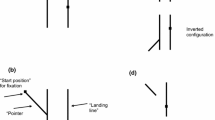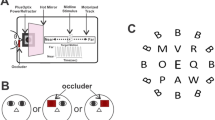Summary
This investigation attempts to examine the change of retinal local signs during voluntary horizontal saccadic eye movements. The method used was to expose the S. to a short light stimulus (electronic flash) of approximately one degree angular width during or after a 16 degree eye movement. The stimulus was released by the eye movement itself via the retino-corneal potential. The S.'s task was to localize the stimulus on a fixed luminous scale.
Clear translatory illusions occurred in these experiments. They depended systematically on the spot on the retina stimulated, and on the time elapsed between the onset of the saccade and the release of the stimulus. These illusions are best interpreted as due to the shift of a “coordinate system” across the retinal field. The shift is initiated by the coordinate of the retinal spot on which the target of the eye movement was projected before the saccade began. This coordinate rapidly swings into the fovea. The processes on the retinal hemisphere opposite to the target occur at a much slower rate. Moreover, temporary changes of the topology of the coordinate system may take place during the saccade. Their origin is still unclear.
The results of the experiments are discussed in terms of a special model based on the previous explanations of the phenomenon of directional constancy (especially the reafference principle, the attention theories, and MacKays theory).
Zusammenfassung
Die vorliegende Arbeit hatte das Ziel, die „Umstimmung der retinalen Raumwerte“ während willkürlicher horizontaler Blicksprünge (Sakkaden) zu untersuchen.
Die Methodik bestand darin, während oder nach der Augenbewegung kurzzeitig einen ca. 1° großen Lichtreiz (Elektronenblitz) im Gesichtsfeld der Vp zu exponieren, den diese in bezug auf eine kopffeste Skala zu lokalisieren hatte. Die Auslösung des Lichtreizes erfolgte auf elektrookulographischem Weg durch die Augenbewegung selbst.
Bei diesen Versuchen traten in systematischer Abhängigkeit vom retinalen Ort des Reizes und von der zwischen Sakkadenbeginn und Reizexposition verstrichenen Zeit deutliche Verlagerungstäuschungen auf. Sie lassen sich am besten interpretieren, wenn man die Umwertungsprozesse als „Wanderung“ eines lokalisatorischen Bezugssystems über ein zentralnervöses Projektionsfeld der Retina auffaßt. Diese Wanderung wird eingeleitet und angeführt durch ein rasches Einschwingen der Koordinate des Zielpunktes der Blickbewegung in die Fovea; in der zielabgekehrten Netzhauptperipherie vollzieht sich die Umwertung wesentlich langsamer. Dabei kann es vorübergehend zu topologischen Veränderungen des Bezugssystems kommen, deren Genese noch unklar ist.
Ausgehend von den bislang vorliegenden Ansätzen zur Erklärung der Richtungskonstanz (insbesondere vom Reafferenzprinzip, den Aufmerksamkeitstheorien und der Theorie MacKays) wird ein eigenes Modell entwickelt, in dessen Rahmen die Versuchsergebnisse diskutiert werden.
Similar content being viewed by others
Literatur
Auersperg, Prinz A., u. H. Sprockhoff: Experimentelle Beiträge zur Frage der Konstanz der Sehdinge und ihrer Fundierung. Pflügers Arch. ges. Physiol. 236, 301–320 (1935).
Bischof, N.: Untersuchungen zur Psychophysiologie der Richtungskonstanz. In: G. Lienert (Hrsg.), Ber. 23. Kongr. Dtsch. G. f. Psychol., S. 170–171. Göttingen: Hogrefe 1963.
—: Psychophysik der Raumwahrnehmung. In: W. Metzger (Hrsg.), Handbuch der Psychologie, Bd. 1/1, S. 307–408. Göttingen: Hogrefe 1966.
Ditchburn, R. W., and B. L. Ginsborg: Involuntary eye movements during fixation. J. Physiol. (Lond.) 119, 1–17 (1953).
Grüsser, O. J., u. U. Grüsser-Cornehls: Periodische Aktivierungsphasen visueller Neurone nach kurzen Lichtreizen verschiedener Dauer. Pflügers Arch. ges. Physiol. 275, 292–311 (1962).
Gurevitch, B.: Possible role of higher proprioceptive centres in the perception of visual space. Nature (Lond.) 184, 1219–1220 (1959).
Hillebrand, F.: Die Ruhe der Objekte bei Blickbewegungen. Jb. Psychiatr. Neurol. 40, 213–265 (1920).
—: Zur Theorie der stroboskopischen Bewegungen. Z. Psychol. 89, 209–272 (1922).
—: Zur Theorie der stroboskopischen Bewegungen. Z. Psychol. 90, 1–66 (1922).
Hofmann, F. B.: Die Lehre vom Raumsinn des Auges. Berlin: Springer 1925.
Holst, E. v., u. H. Mittelstaedt: Das Reafferenzprinzip. Naturwissenschaften 37, 464–476 (1950).
Kaila, E.: Die Lokalisation der Objekte bei Blickbewegungen. Psychol. Forsch. 3, 60–77 (1923).
Ludwigh, E.: Possible role of proprioception in the extra-ocular muscles. Arch. Ophthal. 48, 436–441 (1952a).
—: Control of ocular movements and visual interpretation of the environment. Arch. Ophthal. 48, 442–448 (1952b).
Mach, E.: Die Analyse der Empfindungen. Jena: Fischer 1885.
MacKay, D. M.: The stabilization of perception during voluntary activity. Proc. 15th Int. Congr. of Psychology, p. 284–285 (1957).
—: Perceptual stability of a stroboscopically lit visual field containing self-luminous objects. Nature (Lond.) 181, 507–508 (1958).
—: Theoretical models of space perception. In: C. A. Muses (Hrsg.), Aspects of the theory of artificial intelligence, p. 83–104. New York: Plenum Press 1962.
—: Cerebral organization and the conscious control of action. Pontificiae Acad. Sci. Scripta Varia 30, p. 627–663. Civitas Vaticana 1965.
Mackensen, G.: Elektrische Registrierung von Augenbewegungen. (Elektrookulographie, Elektronystagmographie). Hausnachrichten der P. Schwarzer GMBH, München, Sonderheft 1957.
Matin, L., and D. G. Pearce: Visual perception of direction for stimuli flashed during voluntary saccadic eye movements. Science 148, 1485–1488 (1965).
Metzger, W.: Psychologie, 2. Aufl. Darmstadt: Steinkopff 1954.
Monnier, M.: Retinal, cortical and motor responses to photic stimulation in man. J. Neurophysiol. 15, 469–486 (1952).
Rutschmann, R.: Perception of temporal order and relative visual latency. Science 152, 1099–1101 (1966).
Sherrington, Ch.: Observations on the sensual role of the proprioceptive nerve-supply of the extrinsic ocular muscles. Brain 41, 332–343 (1918).
Author information
Authors and Affiliations
Additional information
Diese Arbeit wurde mit Unterstützung der Deutschen Forschungsgemeinschaft ausgeführt. Wir danken unseren Versuchspersonen für ihre ausdauernde Mitarbeit sowie Frau Dipl.-Psych. Doris Bischof, Herrn Peter Heinecke und Frau Dr. Maria V. Schaetz für ihre Hilfe bei der Durchführung und Auswertung der Versuche.
Rights and permissions
About this article
Cite this article
Bischof, N., Kramer, E. Untersuchungen und Überlegungen zur Richtungswahrnehmung bei willkürlichen sakkadischen Augenbewegungen. Psychol. Forsch. 32, 185–218 (1968). https://doi.org/10.1007/BF00418660
Received:
Issue Date:
DOI: https://doi.org/10.1007/BF00418660




